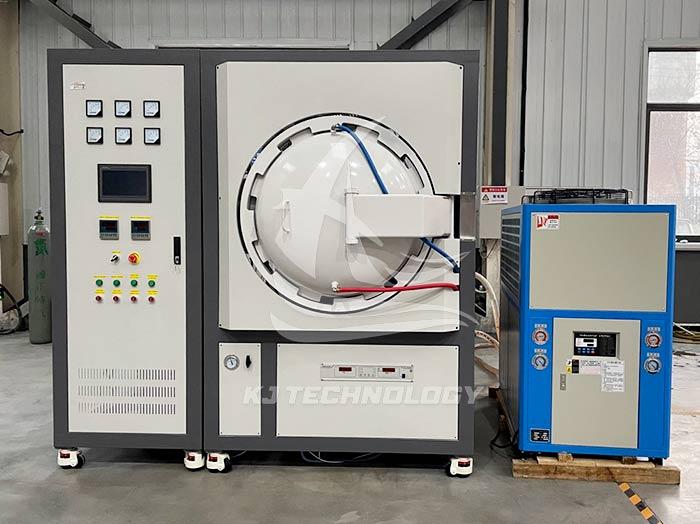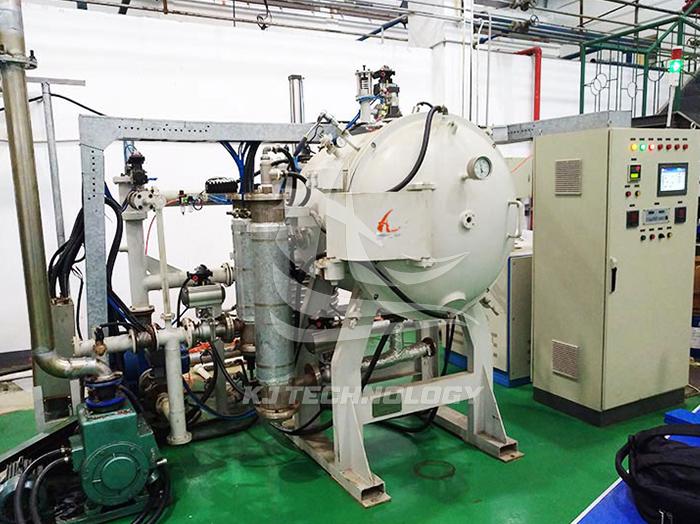Precautions for using a vacuum atmosphere muffle furnace
 09-12-2025 Author: KJ technology
09-12-2025 Author: KJ technology
The vacuum atmosphere muffle furnace is a precision equipment used for material processing under high temperature and vacuum or specific atmosphere conditions, widely used in materials science, metallurgy, chemical engineering and other fields. To ensure the safe operation of the equipment, extend its service life, and obtain accurate experimental results, the following precautions should be taken when using it:
1. Preparation before operation
environment check
Ensure that the equipment is placed in a well ventilated, dry, and non corrosive gas environment, away from flammable and explosive materials.
Check if the power supply voltage matches the equipment requirements and confirm reliable grounding.
Clean up the debris around the furnace body to avoid affecting heat dissipation or operational safety.
Equipment inspection
Check if the sealing strip of the furnace door is intact, without aging, cracking or deformation, to ensure vacuum sealing.
Confirm that the observation window, thermocouple, air inlet/outlet and other components are securely installed without looseness or damage.
Check if the oil level of the vacuum pump is normal (usually located at 1/2~2/3 of the oil window), the oil quality is clear and free of contamination.
Test the emergency stop button function to ensure that the power can be quickly cut off in case of emergencies.
Workpiece preparation
Select appropriate workpiece materials and sizes according to process requirements to avoid uneven heating caused by overloading or irregular shapes.
Clean the surface oil and impurities of the workpiece to prevent volatilization and pollution of the furnace or affecting the vacuum degree at high temperatures.
Use fixtures with high temperature resistance and low gas release rate (such as alumina ceramics, graphite) to prevent metal fixtures from deforming or reacting with workpieces at high temperatures.
2. Operation process specification
Heating and insulation
Segmented heating: Set a reasonable heating program based on material characteristics to avoid short-term and significant heating that may cause thermal stress cracking. For example:
Room temperature to 300 ℃: Slowly raise the temperature (≤ 5 ℃/min) to evenly heat the material.
300 ℃ to target temperature: Adjust the rate according to process requirements (such as 10 ℃/min), but further reduce the rate in the high temperature range (>800 ℃).
Insulation time: Ensure that the workpiece fully reaches thermal equilibrium and avoid uneven performance caused by excessive temperature gradients.
Overtemperature protection: Set a temperature upper limit (such as 50 ℃ higher than the target temperature) to prevent danger caused by temperature control system failure.
Vacuum and Atmosphere Control
Vacuum pumping:
After closing the furnace door, first turn on the mechanical pump to pre pump to a lower vacuum degree (such as 10 ³ Pa), and then switch to the molecular pump to pump high vacuum (such as 10 ⁻ Pa).
During the vacuum pumping process, observe the pressure changes. If the pressure rises too quickly, there may be leaks, and the machine needs to be stopped for inspection.
Atmosphere filling:
When it is necessary to fill protective gases (such as argon or nitrogen), first introduce a small amount of gas to empty the residual air in the furnace, and then adjust it to the required process pressure.
Maintain stable gas flow to avoid gas impact on workpieces or thermocouples.
Vacuum monitoring: Regularly calibrate the vacuum gauge to ensure accurate readings and avoid material oxidation or experimental failure due to insufficient vacuum.
Temperature measurement and calibration
Regularly calibrate the equipment temperature using standard thermocouples or infrared thermometers to ensure that the displayed value deviates from the actual value within the allowable range (such as ± 5 ℃).
Avoid direct contact between thermocouples and workpieces or furnace walls to prevent measurement errors or damage to the probe.
Reduce the number of furnace door openings at high temperatures (>1000 ℃) to prevent cold air from entering and causing a sudden drop in temperature.
3. Safety protection measures
personal protection
Wear heat-resistant gloves, protective goggles, and dust masks during operation to avoid burns from high temperatures or inhaling harmful gases.
It is prohibited to directly touch the furnace body, furnace door or high-temperature workpieces with hands. Special tools (such as long handled clamps) must be used.
Equipment safety
Flammable and explosive materials are strictly prohibited from being placed in the furnace to prevent high temperatures from causing fires or explosions.
Regularly check the insulation performance of heating elements and power lines to prevent leakage or short circuits.
Do not close the intake valve when the vacuum pump is running to prevent oil backflow from damaging the pump body.
emergency response
In case of emergency (such as leakage, abnormal noise, temperature loss), immediately press the emergency stop button, cut off the power and notify the maintenance personnel.
When the vacuum system leaks, close all valves and slowly release the pressure inside the furnace to avoid rapid pressure relief that may cause splashing of the workpiece.
In case of fire, use dry powder extinguisher to extinguish the fire. It is forbidden to use water or foam extinguisher.
4. Maintenance and upkeep
Daily cleaning
Clean the residue and oxides in the furnace after each experiment to prevent dust accumulation from affecting heating efficiency or contaminating subsequent experiments.
Wipe the surface of the furnace body with a soft cloth and avoid using corrosive cleaning agents.
Regular maintenance
Weekly: Check the oil quality of the vacuum pump and replace it if necessary; Clean the dust from the cooling fan.
Monthly: Calibrate temperature controller and vacuum gauge; Check if the heating element connection is loose.
Every six months: replace sealing strips and thermocouples; Check the integrity of the furnace insulation layer and repair any cracked or detached parts.
Long term discontinuation
Evacuate the furnace and close all valves to prevent moist air from entering and causing corrosion.
Cut off the power, cover the equipment with a dust cover, and store it in a dry and ventilated place.
Before reactivation, a comprehensive inspection and trial operation are required to ensure the normal performance of the equipment.
5. Special process precautions
high-temperature quenching
When rapid cooling is required, prepare the quenching medium (such as oil or water) in advance and ensure that the medium temperature meets the process requirements.
During the quenching process, stay away from the furnace body to prevent the medium from splashing and injuring people.
Atmosphere Reaction Experiment
Before filling the reaction gas (such as hydrogen, oxygen), the air inside the furnace must be completely emptied to prevent explosion.
Strictly control the gas ratio and pressure to avoid uncontrolled reactions.
long-running
When operating continuously for more than 24 hours, it is necessary to strengthen inspections and monitor changes in parameters such as temperature, vacuum degree, and current.
Avoid overloading the equipment to prevent accelerated aging of heating elements or deformation of the furnace.








